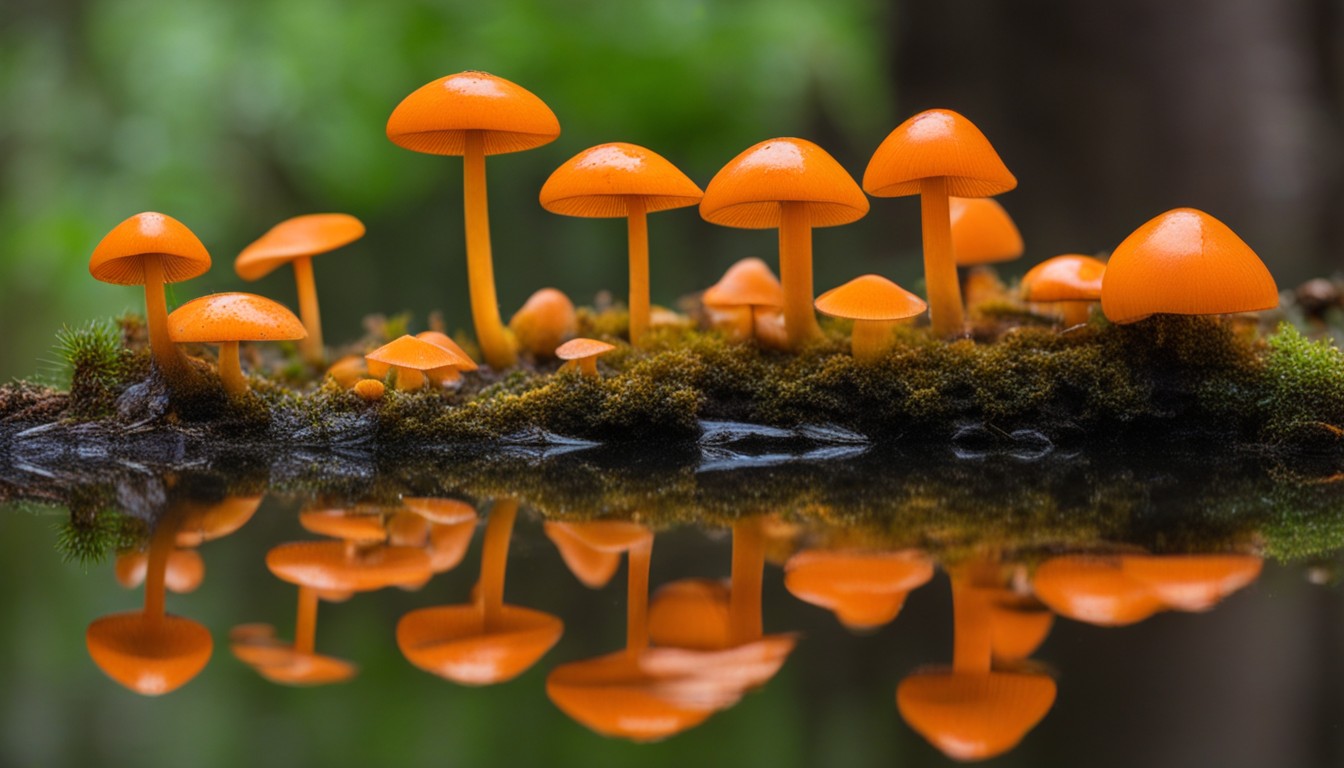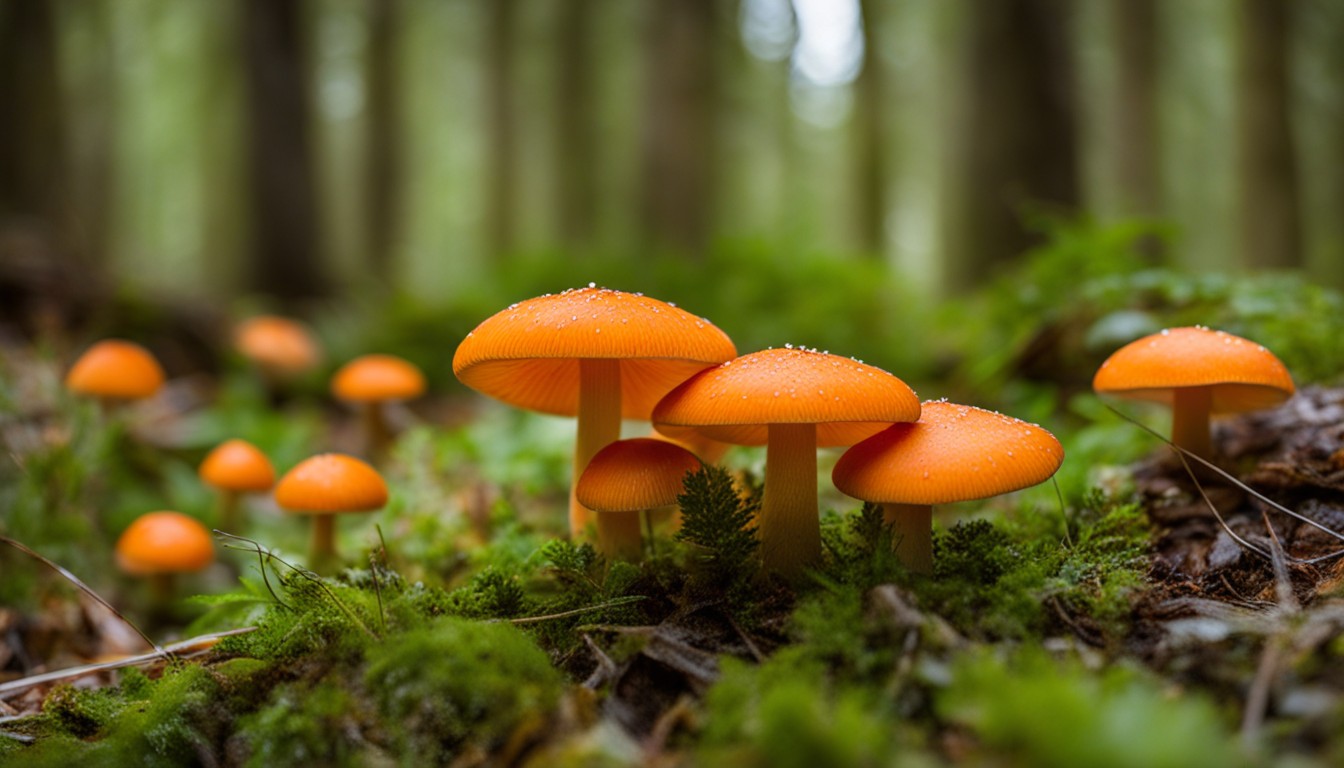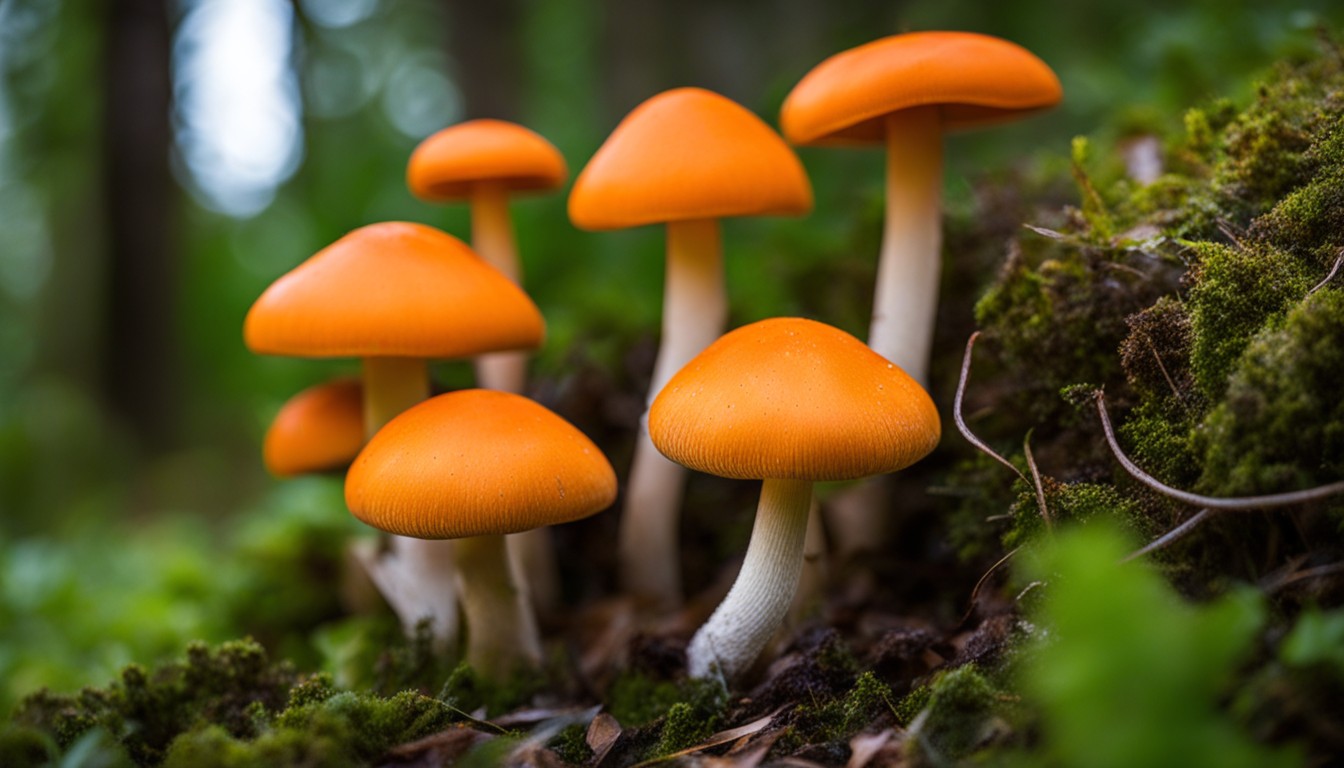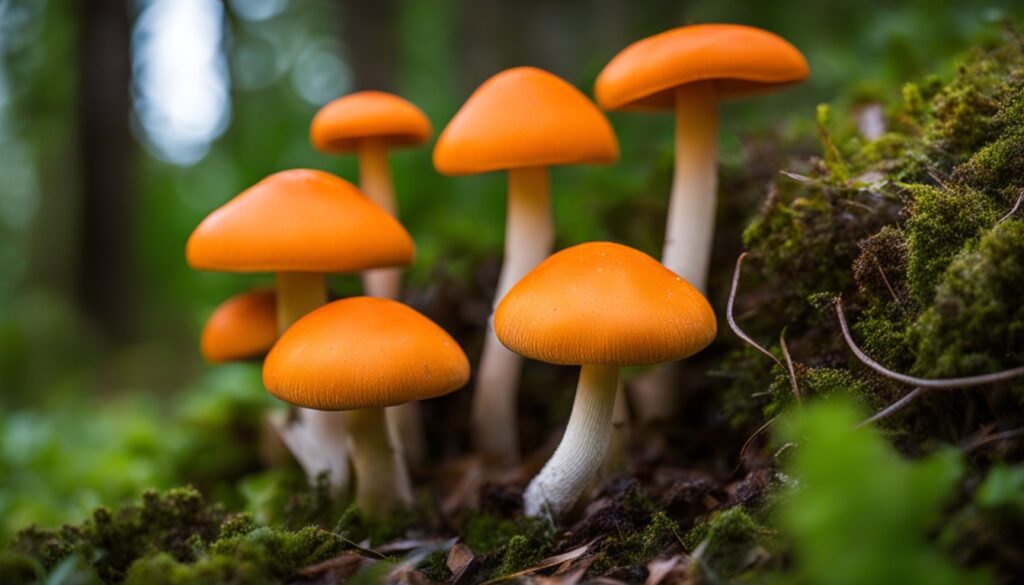Orange mushrooms can be found throughout the state of Maine, offering a fascinating and diverse array of species to discover and explore. From the vibrant orange caps to the unique shapes and sizes, these mushrooms add a burst of color and intrigue to the forest floor. This guide will help you identify orange mushrooms in Maine and provide tips for safely and responsibly enjoying your mushroom exploration adventures in the state. Whether you’re a seasoned mushroom enthusiast or a curious nature lover, this guide will enhance your appreciation for the beauty and biodiversity of Maine’s orange mushrooms.
Different Types of Orange Mushrooms in Maine
Unveiling the world of orange mushrooms in Maine, the landscape brims with a tapestry of fascinating fungal specimens. Of these, Chanterelles, Lobster Mushrooms, and Chicken of the Woods are the most notable, captivating foragers with their vibrant colors and unique characteristics.
Maine offers a rich diversity of orange mushrooms, featuring Chanterelles’ delicate gills, Lobster Mushrooms’ robust texture, and the large, shelf-like structure of Chicken of the Woods.
When viewing these various orange mushrooms through a comparative lens, one can recognize unique attributes. Chanterelles boast delicate gills, Lobster Mushrooms impress with their robust texture and reddish hue, and Chicken of the Woods impresses with its large, shelf-like structure.
Chanterelles
Chanterelles, a variety of orange mushroom, are distinguished by their umbrella-shaped caps and radiating gill-like ridges underneath. Found predominantly in hardwood forests, they flourish in moist areas near oak trees and form an intriguing part of Maine’s mycology.
Considered among the most delicious wild fungi, Chanterelles enrich your meals with their subtly fruity aroma and a peppery finish. They pack a nutritional punch being rich in vitamins C and D, and essential minerals like potassium.
Harvesting Chanterelles demands caution. Over-picking can lead to a population drop. Collect mature mushrooms leaving behind youngsters, offering them a chance to spore and ensure future growth.
Ensure to cut or pluck these mushrooms cleanly at the base of their stalks, attempting not to disturb their mycelium. This practice aids in their sustainable harvesting, assisting in their healthy regrowth.
Cooking these fungi is a treat. Use Chanterelles as an exquisite ingredient in various gourmet dishes, honoring their robust flavor and nutritional richness. Remember, never consume them raw to avoid potential toxins.
Lobster Mushrooms
Often mistaken for the remnants of a lobster feast, Lobster Mushrooms are a curious variety with a namesake rustic orange hue. Their unique, crustacean-like look comes from a Hypomyces fungus that parasitizes certain mushroom species transforming them into Lobster Mushrooms.
Packing an impressive nutritional punch, these mushrooms are rich in fiber, protein, and essential vitamins. However, procuring wild Lobster Mushrooms mandates extreme caution due to their resemblance to some toxic varieties. Always ensure positive identification before consumption.
Their ecological role is twofold – as parasites, they regulate host mushroom populations, and as saprophytes, they aid in degrading organic matter, recycling critical nutrients back into the woodland ecosystem. Comprehension of this interplay is key to appreciating their true value.
Chicken of the Woods
Chicken of the Woods is an orange mushroom easily identifiable by its vibrant cap and its fan-like, overlapping growth pattern on trees. Often found in hardwood forests, it favors dead or decaying logs for growth. Notably, it serves as a popular culinary choice due to its chicken-like taste and texture.
In a fascinating symbiotic relationship with the forest, Chicken of the Woods helps in maintaining forest health. By breaking down the tough lignin and cellulose found in deadwood, it plays an essential role in recycling nutrients back into the forest ecosystem.
It is worth mentioning, however, that like any good thing, moderation is key. Over-harvesting risks disrupting this delicate ecosystem balance and deprives other forest organisms of a key player in nutrient cycling. Hence, ensure your foraging practices are responsible and sustainable.
Identifying Orange Mushrooms in Maine

Identification of orange mushrooms in Maine requires keen attention to detail, focusing on features like color, texture, spore prints, and the presence and type of gills or pores. These steps, along with noting the shape and size of the mushroom, allow for accurate identification and safe foraging.
Understanding the risks and benefits involved in mushroom foraging gives importance to proper identification. Without thorough knowledge, one might miss out on unique orange mushrooms native to Maine, or worse, mistakenly harvest poisonous varieties. Knowledge and preparation are key to a positive foraging experience.
Color and Texture
Investigating the role of color and texture is pivotal in identifying orange mushrooms in Maine. This link between the morphology of mushrooms and their ecological role provides key insights for in-depth identification.
- Take note of variations in color intensity and pattern, as these can indicate different species.
- Consider the texture of the cap – some mushrooms may be slimy, smooth, or dry.
- Observe whether the mushroom’s color is consistent or changes with age or weather conditions.
- Examine the undersurface for helpful clues; changes in color or texture here can be significant.
- Understand that color and texture both play a crucial role in a mushroom’s ecological function, impacting its ability to blend, reproduce, and survive.
Spore Print
For accurate identification of orange mushrooms in Maine, an essential step is examining the spore print. This diagnostic method offers deep insights into the type of the mushroom, supporting other identification methods, and bolstering the confidence in final determination.
- Understanding the color variations in spore prints
- Learning how to properly conduct spore print analysis
- Recognizing the relationship between spore print color and mushroom species
- Appreciating the microscopic beauty of diverse spore forms and patterns
Gills or Pores
One key feature in identifying orange mushrooms is the presence of gills or pores underneath the cap. This distinct structural element is fundamental to mushroom identification and varies in detail among different species.
- Different mushroom species exhibit varying gill or pore patterns, which can be a crucial identification difference.
- Some orange mushrooms, like chanterelles, display false gills, which are vein-like ridges rather than actual gills.
- Pore-bearing mushrooms, such as Chicken of the Woods, have a sponge-like surface instead of gills.
- Attention to color, size, and spacing of the gills or pores can aid in correct mushroom identification.
- Note that mushrooms with green or yellow spores usually deposit them on their gills or pores.
Shape and Size
The geography of Maine, with its diverse ecosystems, significantly influences the shape and size of orange mushrooms. Forested regions, coastal areas, and mountainous terrains lend to an array of morphological differences among specimens.
- Due to variations in geographical conditions, mushroom size can range from tiny, less than an inch, to huge, spanning several feet.
- The shape of orange mushrooms often varies, appearing in classic cap-and-stem configurations to more unique formations, such as shelves or rosettes.
- Some mushrooms might have fluted or ruffled edges, while others might possess smooth, unbroken caps.
- The size of mature fungi can be influenced by factors such as the availability of nutrients, moisture, and ideal growth conditions.
Safety Precautions for Mushroom Foraging
The first step in ensuring a safely aventurous foray into Maine’s orange mushroom scene prioritizes adequate research and education. Do not venture out unprepared; familiarity with the distinctions between edible types and their deadly lookalikes is paramount.
While hunting for orange mushrooms in Maine offers an intricate balance between the thrill of exploration and the inherent risks, always adhere to rigorous safety measures. Avoid unknown mushrooms, use proper harvesting techniques, and when in doubt, consult an expert to forestall potential hazards.
Research and Education
In-depth research is crucial for comprehending the diverse species of orange mushrooms found in Maine. This information is key not only for identification but also for understanding their nutritional profiles and potential culinary uses. Moreover, it can help foragers differentiate between edible and potentially harmful species.
Several educational resources can aid aspiring orange mushroom foragers in Maine. Books, online courses, and attending local workshops conducted by expert mycologists are all viable options. These resources often cover details of mushroom identification, biology, and safe foraging practices.
Accessing local mycology clubs or participating in mushroom identification programs organized by local universities and conservation groups can supply valuable hands-on experience. Such initiatives allow novices to learn directly from experienced foragers and experts, accelerating their overall understanding.
Through diligent research and education, foragers can responsibly enjoy the bounty of Maine’s orange mushrooms. The knowledge gained aids in preserving the natural ecosystem, while providing a profound appreciation for the fascinating world of mycology.
Avoid Unknown Mushrooms

Consumption of unidentified orange mushrooms poses a perilous risk, from mild gastrointestinal disorders to severe neurological impacts. Not every orange fungus in Maine is safe to eat, hence adequate identification is paramount.
Exercising prudence while foraging mushrooms decreases the risk of inadvertent poisoning. When in doubt, it’s wise to leave the unidentified mushroom untouched.
The world of mycology is replete with several look-alikes. A simple misidentification can lead to ingestion of toxic or inedible species, underscoring the need for erring on the side of caution and avoiding unknown mushrooms.
Proper Harvesting Techniques
When foraging for orange mushrooms in Maine, remember the principle of sustainable harvesting. It’s a blend of art and science: leave enough mature mushrooms for spore propagation and only take what you need.
Best practices for balancing your foraging activities with conservation include focusing on abundant species and avoiding disturbing root structures. This helps maintain the mushroom population and the health of the Maine woods ecosystem.
Adopting proper techniques such as cutting, not pulling, can make a huge difference in future regrowth. Handling collected mushrooms gently and storing them in a breathable container helps preserve their quality on the journey home.
Consult Experts
Enlisting the help of professional guides for orange mushroom identification significantly enhances your foraging experience. Their expertise provides you confidence when identifying risk-free edible mushrooms, ensuring your safety while exploring Maine’s wilderness.
In situations of doubt during orange mushroom foraging, mycologists play a pivotal role. Their extensive knowledge in mushroom species helps confirm the identification, dispelling uncertainties and thus, preventing possible dangerous ingestions.
Popular Locations for Orange Mushroom Exploration in Maine

Maine’s biodiversity unfolds beautifully as one explores Acadia National Park, Baxter State Park, Mount Desert Island, and Western Foothills Region, favorite haunts of orange mushroom foragers. These locations excel in offering a rich habitat for mycological wonders.
Boasting high fungal diversity, these iconic areas in Maine become a trail map for enthusiasts keen on discovering locally prevalent orange mushroom species. Their lush trails and varied terrains make them perfect for a guided or self-led mushroom foraging expedition.
Acadia National Park
Acadia National Park, a biodiversity hotspot in Maine, is characterized by a fascinating ecosystem perfect for the growth of orange mushrooms. It offers a variety of habitats, each hosting a unique array of vibrant fungal specimens.
Take the Orange Mushroom Trail for an unforgettable foraging adventure in Acadia National Park. The path guides you through thickets and clearings, every turn revealing the wonders of nature in the form of bright, beguiling orange mushrooms.
Baxter State Park
Baxter State Park is a haven for mycologists and foragers, its diverse ecosystems home to an array of unique orange mushrooms. The park’s mix of woodlands and wetlands provide the perfect habitat for these fungi, revealing countless mycological secrets for the observant explorer.
A forager’s delight, Baxter State Park offers an abundance of trails where the orange mushrooms thrive. Whether you’re an experienced forager or a novice, the park provides ample opportunities to delve into the world of orange mushroom identification and exploration.
Mount Desert Island
Mount Desert Island is a hotspot for the diverse and vibrant world of orange mushrooms that Maine has to offer. Its diverse habitats provide an ideal growth environment for these sunset-hued fungi, from coastal woodlands to highland heaths.
A fun and rewarding activity for island visitors and locals alike is foraging for orange mushrooms. This activity provides an opportunity to connect with nature and enjoy the breathtaking beauty of the island while engaging in a form of treasure hunting.
Orange mushrooms on the island comprise of an array of species each distinct in size, shape and texture. Learning to correctly identify them is important, not just for foraging, but also for broadening one’s knowledge of native fungi.
Many individuals use field guides, mobile apps, and spore printing as effective identification tools for these organisms. It is important to note that each type of orange mushroom has a specific signature when it comes to color, texture and the presence or absence of gills or pores.
It’s not all about finding edible mushrooms, for the casual observer or photographer, the enchanting world of orange mushrooms on Mount Desert Island provides a wonderland of colors, shapes and textures to marvel and learn about.
Western Foothills Region
Maine’s Western Foothills Region is an intriguing landscape to explore for orange mushroom enthusiasts; its variety of microclimates and dense forestation make it a fruitful location. The diverse terrain encourages organic growth, introducing a myriad of orange mushroom species to the area.
Within these natural perimeters, mushroom foragers find a bountiful collection. The combination of rich soil, mossy beds, and ample tree coverage provides an ideal habitat for mushrooms, mainly the orange variety. This region constantly delivers surprises for hobbyist and seasoned mycologists alike.
From the Western Foothills’ lush forests to its hidden meadows, the area does not disappoint any mushroom picker. While the Chanterelles and Chicken of the Woods are common, unexpected species like the elusive Jack-o-Lantern may surprise foragers. For this reason, continued exploration of this region is highly encouraged.
The Western Foothills’ beauty only adds to the joys of mushroom picking. Each foraging journey is not just a chance to find remarkable orange mushrooms, but also an excuse to appreciate Mother Nature’s artistry. This mixture of serene beauty and foraging excitement creates a captivating experience for mushroom enthusiasts.
Experienced and novice foragers are in for a treat when wandering through the Western Foothills. Simply ensure that the precautions and safety rules are adhered to, enhancing the exploration experience. This region remains a respected landmark in the orange mushroom exploration culture of Maine.
FAQ: Orange Mushrooms in Maine
Discover the answers to commonly asked questions about identifying and exploring orange mushrooms in Maine.
How can I identify orange mushrooms in Maine?
To identify orange mushrooms in Maine, pay attention to their vibrant orange caps, unique shapes, and sizes. It’s important to consult field guides or seek guidance from experienced mushroom enthusiasts to ensure accurate identification.
Are all orange mushrooms in Maine safe to eat?
No, not all orange mushrooms in Maine are safe to eat. Some orange mushrooms can be highly toxic or even deadly. It’s important to never consume wild mushrooms unless you are confident in your identification skills or have an expert confirm their edibility.
Can I forage for orange mushrooms in Maine?
Yes, you can forage for orange mushrooms in Maine, but it’s crucial to do so safely and responsibly. Always obtain the necessary permits, respect private property rights, and follow ethical foraging practices to protect the ecosystem and ensure sustainable harvesting.
What precautions should I take while exploring orange mushrooms in Maine?
When exploring orange mushrooms in Maine, you should wear appropriate clothing and protective gear, such as gloves and a mushroom knife. It’s also important to handle mushrooms carefully and avoid disturbing their natural habitat to preserve the delicate balance of the ecosystem.
Are there any guided tours or groups for mushroom enthusiasts in Maine?
Yes, there are guided tours and groups available for mushroom enthusiasts in Maine. These can provide valuable knowledge, hands-on experience, and a chance to learn from experienced experts in a safe and educational setting.
Can I photograph orange mushrooms in Maine?
Absolutely! Photographing orange mushrooms in Maine is a great way to capture their beauty and document your discoveries. Remember to respect the mushrooms and their environment by not interfering with their natural growth or disturbing surrounding flora and fauna.
What should I do if I suspect I’ve ingested a poisonous orange mushroom in Maine?
If you suspect you have ingested a poisonous orange mushroom in Maine, seek immediate medical attention. Contact a poison control center or your healthcare provider for guidance. It’s crucial to provide accurate information about the mushroom and any symptoms experienced.
Remember, when in doubt, it’s always best to err on the side of caution and consult experts for proper identification and guidance.
Conclusion
As we conclude, keep some vital points in mind. Always combine your intuition with solid education for safe and successful foraging. Oranges mushrooms like Chanterelles, Lobster, and Chicken of the Woods, are a delightful find in the vibrant woods of Maine. Remember, distinctive features like color, texture, spore print, gills or pores, and size shape will aid in identification. Places such as Acadia National Park, Baxter State Park, Mount Desert Island, and the Western Foothills Region offer fruitful hunting grounds. Happy foraging!
- Key takeaways: Intuition + Education = Safe and successful foraging
- Popular Orange Mushrooms: Chanterelles, Lobster, Chicken of the Woods
- Identification features: Color, Texture, Spore Print, Gills or Pores, Shape and Size
- Prime locations: Acadia National Park, Baxter State Park, Mount Desert Island, Western Foothills Region

